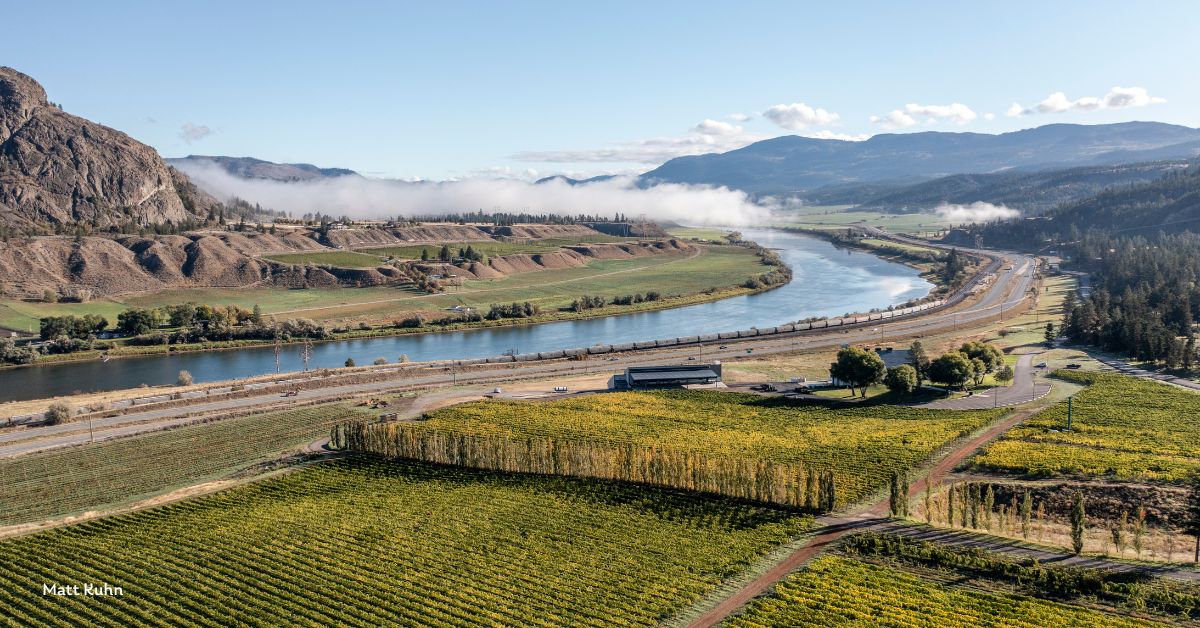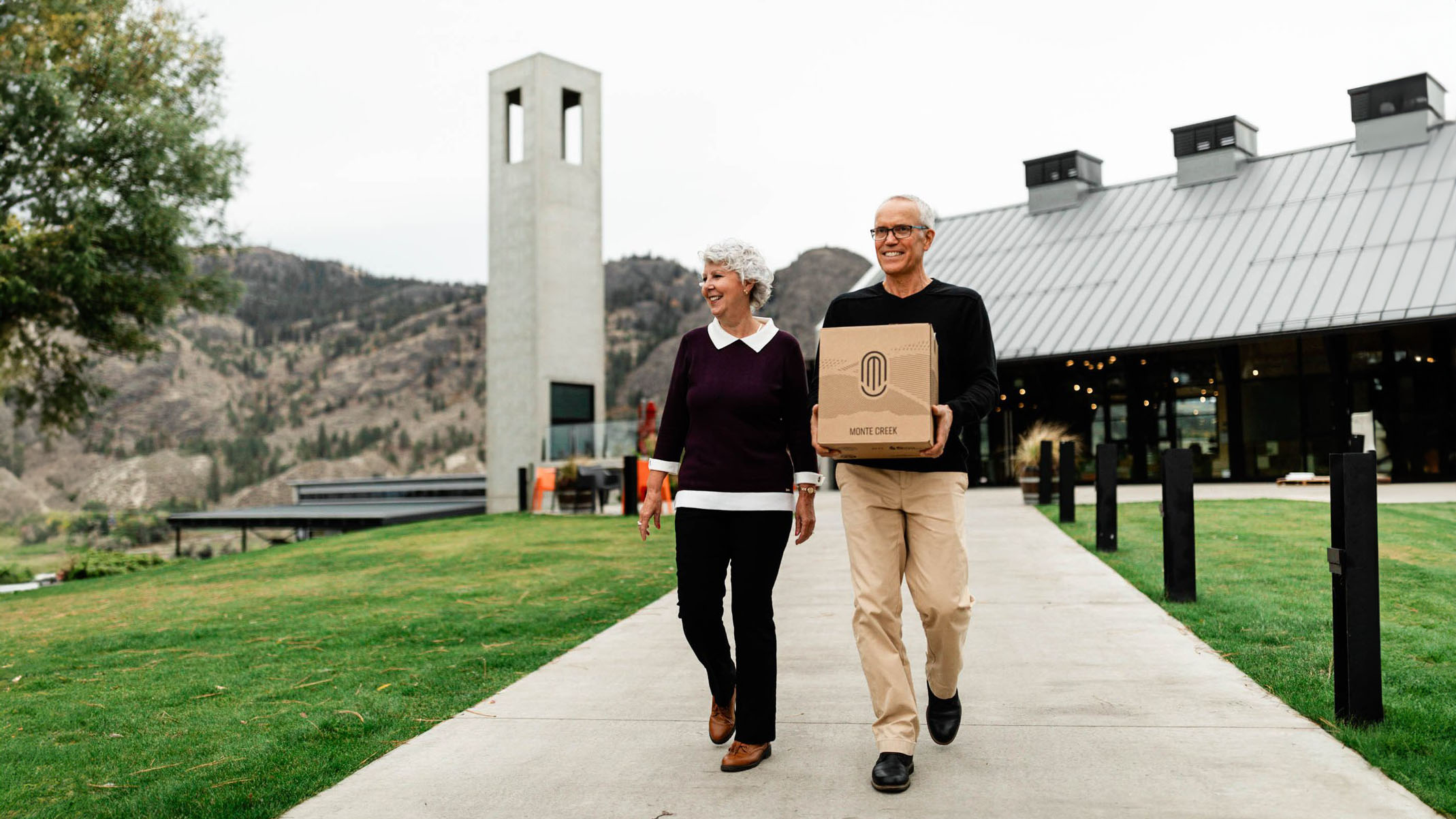Exhilarating, adventurous, and distinctive are a few words that describe the Thompson Valley wine region. Centred around the city of Kamloops, this burgeoning wine region has been growing premium grapes since 2005, and officially received its “Thompson Valley” BC geographic indication in 2018. A boutique region with 4 licensed wineries, 6 commercial vineyards and 125 acres under vine, the Thompson Valley is a unique place and has something special to offer the wine world.
What makes the Thompson Valley wine region so special? What are the similarities and differences to other wine regions that further delineate the story of this extraordinary place? It’s not only the north of 50 latitude on the map that makes this region different, it’s the unique combination of geography, geology, climate, and people; in other words, it’s what the wine world calls terroir that really defines this place.
Terroir (terˈwär, French Terre means “land”) means the conditions and characteristics of the natural environment in which wine is produced including geography, soil, and climate. Terroir is the romance between vines and where they grow.
Let’s dive deeper into what influences terroir and makes the Thompson Valley’s terroir one-of-a-kind.

Geography
North of Normal
Geographically speaking, the Thompson Valley is an extraordinary place for wine. Growing grapes at a latitude of 50.6 is a new boundary for cool climate viticulture and winemakers in the Thompson Valley are pushing those boundaries when it comes to premium grape growing. “It’s when wineries are pushing boundaries that exciting, unique, and delicious wines are made,” says Monte Creek Winery’s winemaker Galen Barnhardt. This is winemaking on the edge, it is exhilarating and adventurous and it’s a nod to the future as the wine regions around the world deal with global warming. The Thompson Valley is one step ahead of what may become a new norm, and the vibrant, well balanced quality wines coming out of the region would suggest that to be true.
Wondrous Waters
The Thompson Valley wine region is located at the confluence of the North and South Thompson Rivers in Kamloops, which is named after the Secwepemc word “Tk’emlúps”, meaning “where the rivers meet”. These rivers not only characterise the beautiful landscape of the valley, but also add an important element to the local terroir. Having a body of water near a vineyard is beneficial for temperature control and air flow. The water will keep areas cooler or warmer depending on the season, which helps to protect vine health. A consistent flow of water also helps to keep the air moving in the valley to reduce the pressure from pests such as bugs or mildew. An added benefit to being where the two rivers meet, is that visitors can also have fun on and explore the Thompson Valley wine region by water.

Climate
Endless Summer
Contrary to what you might think when you hear about cool climate viticulture which is a function of our northern latitude, the Thompson Valley wine region is actually classified as semi-arid with dry desert‑like conditions. This means hot, summer days and cool nights. The extreme temperature shifts between day and night (diurnal temperature) is a climatic blessing that results in the beautiful natural acidity signature to the wines from this region. In addition, the Thompson Valley boasts 2,013 hours of annual sunshine. That’s more daylight than Napa Valley! The accumulated heat, sunshine and dry conditions not only helps to ripen the grapes but also creates a very attractive climate to visit that supports an abundance of outdoor activities and agritourism experience. The Kamloops Wine Trail offers vineyard tours, wine tastings, live music, seasonal dining and more for visitors.

Soil
Unique Landscape
What we are made of truly defines us and in the case of the Thompson Valley wine region, the soil is the secret. The Thompson Valley was carved out by the Kamloops Lake glacier activity pushing south thousands of years ago. Significant glacial episodes and slow-moving meltwaters of the past not only sculpted the valley landscape (picture golden grasslands, sandstone canyons and chiselled hoodoos) that we see today, but also blessed the region with deep layers of silt, sand and clay rich in calcium carbonate that make up the “Glaciolacustrine” (glacial lake) soil we see today. These mineral rich soils made up of limestone and calcium carbonate add to the complexity, flinty notes, and elegant minerality in the wines – a very desirable and sought after characteristic in wine.
Vine Stress
Stress in the vineyard creates tension and that’s a good thing in wine.The northern latitude, large temperature swings and dry soils in the Thompson Valley region create that tension. It forces the vines here to focus hard on the grape and not so hard on the leaf production. Ultimately this tension creates more concentrated flavours in the grapes and more complexity in the wines. Ironically this is one element of terroir that doesn’t translate to the people or the visitor experience in this place. The vibe in Kamloops and around the wineries is quite the opposite. Welcoming, fun and super relaxed comes to mind. So when it comes to wine and wine touring in Kamloops, we’ll let the vines stress out so we don’t have to.

Experience Terroir
The Thompson Valley terroir not only offers a prime wine growing region, but it also offers an adventurous and attractive destination for visitors seeking a never-ending list of activities. Visitors and locals alike can delight in the unique terroir here that enhances both the valley’s award-winning wines and its vacation offerings. Warm sunny days, exciting river-side fun, and spectacular scenery are a highlight when paired with the stunning wines this valley has to offer.
Exploring the secrets of the Thompson Valley terroir (and BC’s most northern wine destination) is a must do this season.



